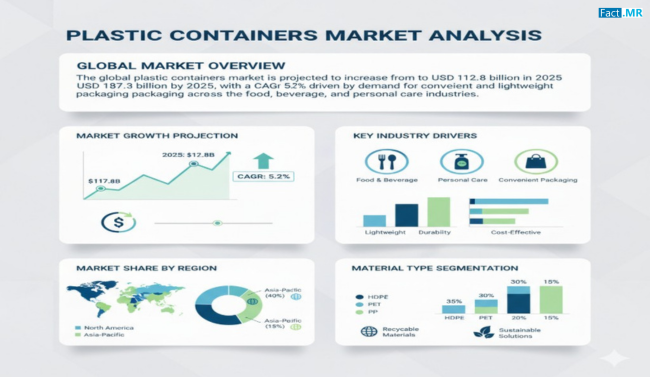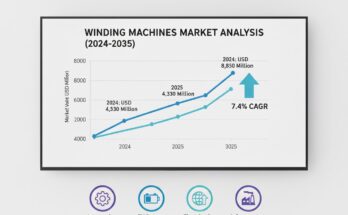In today’s fast-paced consumer landscape, the demand for durable, lightweight, and sustainable packaging has placed plastic containers at the forefront of global packaging solutions. Used across industries ranging from food and beverages to pharmaceuticals and personal care, plastic containers have become indispensable in preserving product integrity, enhancing convenience, and optimizing transportation efficiency. As environmental awareness and packaging innovation continue to evolve, the plastic containers market is undergoing significant transformation toward recyclable and eco-conscious materials.
Market Overview
Plastic containers serve as a crucial link between manufacturers, retailers, and consumers—offering a balance of protection, cost-effectiveness, and design flexibility. The market’s expansion is supported by the rising need for sustainable, high-performance packaging that meets both consumer expectations and regulatory standards.
The industry is witnessing steady shifts toward eco-friendly resins, lightweighting strategies, and advanced molding technologies that minimize resource usage while improving recyclability. With brands and manufacturers increasingly adopting circular economy principles, demand for reusable and recyclable plastic packaging solutions is gaining strong momentum.
In addition, advancements in barrier technologies have improved the shelf life of perishable goods, making plastic containers an integral part of modern supply chains. Customization capabilities—such as shape, color, and labeling—have also made them a preferred choice for brand differentiation in competitive markets.
Regional Insights
North America leads the plastic containers market, driven by widespread consumer preference for convenience packaging and growing investments in recycling infrastructure. The region’s well-developed retail sector and focus on sustainable packaging are fueling demand for recyclable and lightweight containers.
Europe follows closely, characterized by stringent environmental regulations and strong consumer awareness of plastic waste management. The European packaging industry is actively transitioning to bio-based and recycled polymers to comply with circular economy goals and reduce carbon emissions.
Asia Pacific is emerging as a major hub for plastic container production and consumption. Rapid urbanization, expanding food delivery networks, and a growing middle-class population are accelerating packaging innovation. The region’s manufacturers are increasingly focusing on cost-effective, high-quality, and sustainable plastic container solutions.
Latin America and the Middle East & Africa regions are witnessing steady adoption due to population growth, industrialization, and the expansion of the retail and food service sectors. Governments in these regions are also implementing waste management initiatives to promote sustainable packaging alternatives.
Key Trends & Forecast
The plastic containers market is evolving through a combination of sustainability initiatives, design innovation, and digitalization. Several key trends are shaping its future direction:
- Sustainable and Recyclable Materials:
Manufacturers are prioritizing recyclable plastics such as PET and HDPE, along with bio-based resins derived from renewable resources. The push toward closed-loop systems and post-consumer recycled content is strengthening sustainability across the supply chain. - Lightweighting and Resource Efficiency:
Technological advancements are enabling the production of thinner yet stronger containers, reducing material usage without compromising performance. Lightweight packaging also supports lower transportation costs and reduced carbon emissions. - Growth of E-commerce Packaging:
The boom in online retail and direct-to-consumer delivery has fueled demand for durable, tamper-evident, and protective packaging solutions. Plastic containers provide the strength and flexibility required for efficient e-commerce logistics. - Innovations in Design and Aesthetics:
Brands are investing in visually appealing packaging with advanced labeling, ergonomic designs, and user-friendly features such as resealable lids and dispensing systems to enhance customer experience. - Integration of Smart Packaging Technologies:
Incorporation of QR codes, NFC tags, and digital traceability features is improving transparency, authenticity, and supply chain monitoring. Smart packaging is gaining popularity, particularly in the food and pharmaceutical industries. - Expansion of Circular Economy Practices:
Governments and corporations are collaborating to strengthen recycling networks and encourage the use of recycled materials. Extended Producer Responsibility (EPR) programs are pushing manufacturers to design more eco-efficient packaging solutions. - Emergence of Bioplastics and Compostable Alternatives:
Growing awareness of plastic pollution has accelerated research into bio-based and compostable plastics that mimic traditional plastic functionality while reducing environmental impact.
Applications & End-Use Outlook
Plastic containers find widespread use across multiple industries due to their versatility, durability, and cost efficiency:
- Food and Beverage:
The largest end-use sector for plastic containers, driven by demand for convenience foods, ready-to-drink beverages, and extended shelf-life products. PET bottles, jars, and tubs dominate this segment. - Pharmaceutical and Healthcare:
Plastic containers ensure the safe storage and transport of medicines, medical devices, and diagnostic reagents. Their lightweight, sterile, and tamper-proof qualities make them ideal for healthcare applications. - Personal Care and Cosmetics:
The beauty and hygiene industry relies on plastic containers for attractive, user-friendly packaging. Flexibility in design and transparency supports brand visibility and consumer engagement. - Household and Industrial Chemicals:
Durable HDPE and PP containers are widely used for packaging cleaning agents, lubricants, and agricultural products due to their high chemical resistance and strength. - Retail and Logistics:
Reusable plastic containers are becoming popular in retail and logistics for bulk storage and transportation. They offer long service life, stackability, and reduced material waste compared to single-use options.
Competitive Landscape
The plastic containers market is highly competitive, with both global players and regional manufacturers focusing on innovation, sustainability, and product differentiation. Companies are investing in advanced molding technologies, digital labeling, and material science to meet evolving customer needs and environmental regulations.
Strategic partnerships and collaborations with recycling firms and material suppliers are strengthening the supply chain for sustainable raw materials. Additionally, mergers and acquisitions are enabling key players to expand production capacities and diversify product portfolios across regions.
As consumer preferences shift toward environmentally responsible brands, manufacturers are enhancing transparency through eco-labeling, recyclability claims, and carbon footprint reduction initiatives.
Future Outlook
The future of the plastic containers market will be defined by the balance between performance, affordability, and sustainability. The continued adoption of circular economy models and advances in material innovation are set to reshape the industry’s environmental footprint.
Emerging technologies, such as chemical recycling and bioplastic development, will play a crucial role in addressing plastic waste challenges while meeting consumer demand for sustainable packaging. Meanwhile, digital integration across production and logistics will optimize efficiency and reduce waste.
Manufacturers that embrace sustainable transformation, invest in innovation, and maintain regulatory compliance will be best positioned to thrive in the evolving packaging ecosystem.
Conclusion
The plastic containers market stands at the intersection of convenience, innovation, and environmental responsibility. As industries worldwide transition toward greener packaging solutions, plastic containers continue to offer unmatched versatility and functionality. The path forward lies in reimagining plastic packaging through sustainability, smart design, and circular economy principles—ensuring that convenience and environmental stewardship go hand in hand in the packaging landscape of the future.
Browse Full Report – https://www.factmr.com/report/442/plastic-containers-market



